2 - Nail
Editors: Mills, Stacey E.
Title: Histology for Pathologists, 3rd Edition
Copyright 2007 Lippincott Williams & Wilkins
> Table of Contents > II - Breast > 3 - Breast
3
Breast
Laura C. Collins
Stuart J. Schnitt
Introduction
Remarkable advances in breast imaging over the past decade have provided a variety of noninvasive means to assist in the evaluation of patients with breast disorders (1,2,3,4). Nevertheless, at the present time, histologic examination of tissue specimens remains the cornerstone for the diagnosis of breast diseases, and an understanding of normal breast histology is essential for accurate evaluation of such specimens. It should be noted, however, that what constitutes normal histology in the breast varies according to gender, age, menopausal status, phase of the menstrual cycle, pregnancy, and lactation, among other factors. Therefore, determination of whether a given breast specimen is normal or shows pathologic alterations must take these variables into consideration.
Embryology
Development of the human mammary gland begins during the fifth week of gestation, at which time thickenings of the ectoderm appear on the ventral surface of the fetus. These mammary ridges, also known as milk lines, extend from the axilla to the groin. Except for a small area in the pectoral region, the bulk of these ridges normally regress as the fetus continues to develop. Failure of regression of other portions of the milk lines can result in the appearance in postnatal life of ectopic mammary tissue or accessory nipples anywhere along the milk lines; this phenomenon is most commonly encountered in the axilla, inframammary fold, and vulva (5,6,7).
The earliest stages of breast development are largely independent of sex steroid hormones (8). After the fifteenth week of gestation, the developing breast exhibits transient sensitivity to testosterone, which acts primarily on the mesenchyme. Under the influence of testosterone, the mesenchyme condenses around an epithelial stalk on the chest wall to form the breast bud, the site of mammary gland development. Solid epithelial columns then develop within the mesenchyme, and these ultimately give rise to the lobes or segments of the mammary gland. Portions of the fetal papillary dermis encase the developing epithelial cords and eventually give rise to the vascularized fibrous connective tissue that surrounds and invests the mammary ducts and lobules. The more collagen-rich
P.58
reticular dermis extends into the breast to form the suspensory ligaments of Cooper, which attach the breast parenchyma to the skin. Portions of the mesenchyme differentiate into fat within the collagenous stroma between the twentieth and thirty-second weeks of gestation. During the last eight weeks of gestation, the epithelial cords canalize and branch, forming lobuloalveolar structures as a result of mesenchymal paracrine effects. A depression in the epidermis, the mammary pit, forms at the convergence of the lactiferous ducts. The nipple forms by evagination of the mammary pit near the time of birth.
During the last few weeks of gestation the fetal mammary gland is responsive to maternal and placental steroid hormones, and, as a result, the epithelial cells in the acinar units exhibit secretory activity. At the time of birth, withdrawal of the maternal and placental sex steroids stimulates prolactin secretion, which in turn stimulates colostrom secretion. At this time, both male and female neonates exhibit palpable enlargement of the breast bud. As the serum levels of maternal and placental sex steroid hormones and prolactin decline during the first month of life, secretory activity ends, and the gland regresses and becomes inactive. At this stage, and until puberty, the breast consists primarily of lactiferous ducts that exhibit some branching without evidence of progressive alveolar differentiation, although some rudimentary lobular structures may persist.
Another feature that may be seen in the fetal breast is extramedullary hematopoiesis, and this may persist in the periductal stroma until 4 months of age (9) (Figure 3.1).
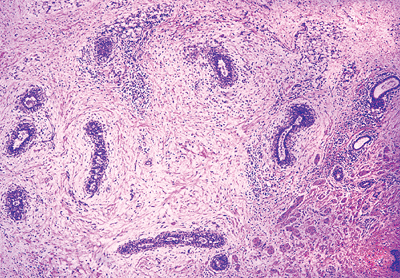 |
Figure 3.1 Breast tissue from an infant showing ducts embedded in a loose connective tissue stroma. The stromal mononuclear cells are hematopoietic elements, indicative of persistent extramedullary hematopoiesis. (Courtesy of Theonia Boyd, M.D, Children's Hospital, Boston, MA) |
Adolescence
Adolescent breast development in the female begins with the onset of puberty and the cyclic secretion of estrogen and progesterone. However, a variety of other steroid and peptide hormones are also required for proper mammary gland development (8) (Table 3.1). The ducts elongate, branch, and develop a thickened epithelium due primarily to the influence of estrogen (10) (Figure 3.2). The process of ductal growth and branching is largely independent
P.59
of progesterone. There is an increase in the density of periductal connective tissue, also as a result of relative estrogen dominance. Deposition of stromal adipose tissue occurs, and it is this adipose tissue that is largely responsible for the enlargement and protrusion of the breast disk at this time. Cyclical exposure to progesterone following exposure to estrogen during ovulatory cycles promotes lobuloacinar growth, as well as connective tissue growth. Although the majority of breast development occurs during puberty, this process continues into the third decade, and terminal differentiation of the breast is only induced by pregnancy.
Table 3.1 Major Steroid and Peptide Hormonal Influences on the Breast (Adapted from Mccarty and Nath (8)) | ||||||||||||||||||||
|---|---|---|---|---|---|---|---|---|---|---|---|---|---|---|---|---|---|---|---|---|
|
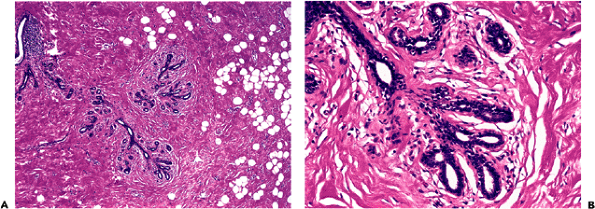 |
Figure 3.2 Adolescent breast tissue composed of branching ducts with rudimentary lobule development (type 1 lobules). The stroma consists a mixture of fibrous connective tissue and adipose tissue. A. Scanning magnification. B. High power. |
The adolescent male breast is composed of fibroadipose tissue and ducts lined by low cuboidal cells.
The Adult Female Breast
The size of the breast is greatly influenced by the individual's body habitus since the breast is a major repository for fat; it can range in size from 30 g to more than 1000 g. The breast lies on the anterior chest wall over the pectoralis major muscle and typically extends from the second to the sixth rib in the vertical axis and from the sternal edge to the midaxillary line in the horizontal axis. Breast tissue also projects into the axilla as the tail of Spence. The breast extends laterally over the serratus anterior muscle and inferiorly over the external oblique muscle and the superior rectus sheath. The breast lies within a space in the superficial fascia, which is continuous with the cervical fascia superiorly and the superficial abdominal fascia of Cooper inferiorly. The only boundary of the breast that is anatomically well-defined is the deep surface where it abuts the pectoralis fascia. However, despite this macroscopic demarcation, microscopic foci of glandular tissue may extend into and even through the pectoral fascia and may traverse the other anatomic boundaries described above. The clinical significance of this observation is that even total mastectomy does not result in removal of all glandular breast tissue. Bundles of dense fibrous connective tissue, the suspensory ligaments of Cooper, extend from the skin to the pectoral fascia and provide support to the breast.
The adult female breast consists of a series of ducts, ductules, and lobular acinar units embedded within a stroma that is composed of varying amounts of fibrous and adipose tissue. The stroma comprises the major portion of the nonlactating adult breast, and the relative proportions of fibrous tissue and adipose tissue vary with age and among individuals (Figure 3.3).
The ductal-lobular system of the breast is arranged in the form of segments, or lobes. While these segments can be readily appreciated by injecting the ductal system with dyes or radiologic contrast agents (Figure 3.4), they are anatomically poorly defined, and no obvious boundaries can be appreciated between these segments during surgery, upon gross inspection of mastectomy specimens, or on histologic examination. In addition, these segments show considerable individual variation with regard to their distribution, and the ramifications of individual segments may overlap. The segmental nature of some neoplastic processes in the breast, particularly ductal carcinoma in situ, is now widely appreciated, and surgical resection of the involved segment is an important therapeutic goal. Unfortunately, since it is not possible for the surgeon to define intra-operatively the boundaries of the involved segment, performing a segmentectomy to remove the entirety of a diseased segment is at this time more of a theoretical concept than a practically attainable goal.
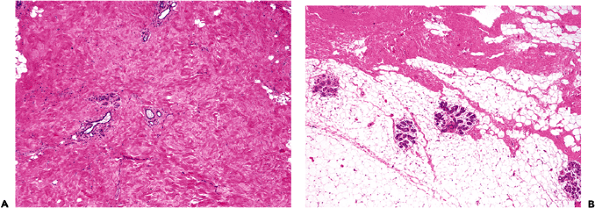 |
Figure 3.3 The stroma is the predominant component of the nonlactating breast and consists of varying amounts of collagen and adipose tissue. A. Low-power view of breast with dense, fibrotic stroma. B. Low-power view of breast with predominantly fatty stroma. |
P.60
Each segment consists of a branching structure that has been likened to a flowering tree (11) (Figure 3.5). The lobules represent the flowers, draining into ductules and ducts (twigs and branches), which, in turn, drain into the collecting ducts (trunk) that open onto the surface of the nipple. Just below the nipple, the ducts are expanded to form lactiferous sinuses. The sinuses terminate in cone-shaped ampullae just below the surface of the nipple.
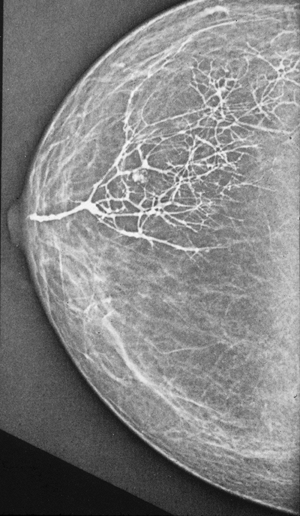 |
Figure 3.4 Ductogram (galactogram). Performed by injecting contrast material into an orifice of a lactiferous duct at the nipple, a ductogram demonstrates the complex ramifications of a single mammary ductal system (also known as a segment or lobe). |
The actual number of segments in the breast and their relationship to each other has long been a matter of debate. Most textbooks indicate that there are 15 to 20 ductal orifices on the nipple surface and suggest that this corresponds to the number of ductal systems, segments, or lobes in the breast (5,6,12,13). In contrast, a number of mammary duct injection studies have suggested that there are only between five and ten discrete breast ductal systems or segments in each breast. The discrepancy between the number of ductal orifices on the nipple and the actual number of breast segments or ductal systems may be explained by the fact that some of the orifices on the nipple represent openings of
P.61
sebaceous glands or other nonductal tubular structures that do not contribute to the ductal-lobular anatomy of the breast. Another possibility is that some lactiferous ducts bifurcate immediately prior to entering the nipple or end blindly (13). The issue of anastomoses between ductal systems is also unresolved. One recent study indicated that, while ductal systems may lie in close proximity to one another and even intertwine within a particular quadrant, they do not interconnect (13). However, anastamoses between ductal systems have been reported by others (14).
 |
Figure 3.5 Microanatomy of normal adult female breast tissue showing extralobular ducts, terminal ducts, and lobules, the latter composed of groups of small glandular structures, the acini. |
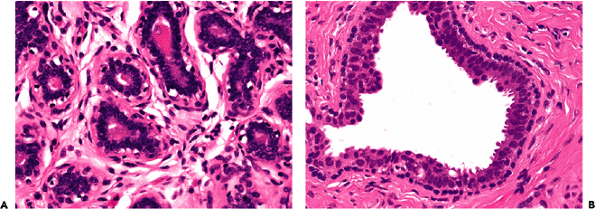 |
Figure 3.6 The mammary ductal-lobular system is lined by a dual cell population, an inner epithelial cell layer and an outer layer of myoepithelial cells. A. High-power view of a lobule. The myoepithelial cells surrounding the acinar epithelial cells are variably conspicuous. B. High-power view of an extralobular duct, showing distinct epithelial and myoepithelial cell layers. |
The epithelium throughout the ductal-lobular system is bilayered, consisting of an inner (luminal) epithelial cell layer and an outer (basal) myoepithelial cell layer. The importance of this double cell layer cannot be overemphasized because it is one of the main guides used to distinguish benign from malignant lesions (15). The luminal epithelial cells of the resting breast ducts and lobules are cuboidal to columnar in shape and typically have pale eosinophilic cytoplasm and relatively uniform oval nuclei. These epithelial cells express a variety of low-molecular weight cytokeratins, including cytokeratins 7, 8, 18, and 19 (16,17,18,19,20). The outer (or myoepithelial) cell layer, although always present, is variably distinctive (Figure 3.6). Myoepithelial cells range in appearance from barely discernible, flattened cells with compressed nuclei to prominent epithelioid cells with abundant clear cytoplasm. In some cases, the myoepithelial cells have a myoid appearance featuring a spindle cell shape and dense, eosinophilic cytoplasm, reminiscent of smooth muscle cells (Figure 3.7). Even when inconspicuous on
P.62
hematoxylin- and eosin-stained sections, myoepithelial cells can readily be demonstrated using immunohistochemical stains for a variety of markers, including S-100 protein, actins, calponin, smooth muscle myosin heavy chain, p63, and CD10, among others (21,22,23) (Figure 3.8). However, these markers vary in both sensitivity and specificity for myoepithelium. Myoepithelial cells also express high molecular weight cytokeratins 5/6, 14, and 17 (16,17,18,19,20,24). Recent work has documented the presence of a third cell type in normal breast tissue. These cells are dispersed individually and irregularly throughout the ductal-lobular system, express the basal cytokeratin CK5, and are thought to be progenitor cells capable of differentiating into both glandular epithelial cells and myoepithelial cells (19). However, the presence of such progenitor cells has not yet been universally accepted (25).
 |
Figure 3.7 Myoepithelial cells can vary in their histologic appearance. A. Myoepithelial cells in this lobule show prominent cytoplasmic clearing. B. In this lobule, the myoepithelial cells show myoid features. |
 |
Figure 3.8 A. Extralobular duct and B. lobule immunostained for p63. The myoepithelial cells show strong nuclear reactivity, whereas the epithelial cell nuclei are negative. C. Double immunostain for smooth muscle actin (red cytoplasmic staining) and p63 (brown nuclear staining) highlight the myoepithelial cells around this mammary duct. Note the lack of staining of the epithelial cells for both p63 and smooth muscle actin. |
A basal lamina consisting of type IV collagen and laminin surrounds the mammary ducts, ductules, and acini (17,26). This basal lamina is present outside of the myoepithelial cell layer and serves to demarcate the breast ductal-lobular system from the surrounding stroma (Figure 3.9). Beyond the basal lamina, the extralobular ducts exhibit a zone of fibroblasts and capillaries. Elastic tissue is normally present in variable amounts around ducts and is generally more prominent in older than in younger women. Elastic fibers are not typically seen around the terminal ducts or acini.
The lobule, together with its terminal duct, has been called the terminal duct lobular unit (TDLU). This represents the structural and functional unit of the breast. During lactation, epithelial cells in both the terminal duct and lobule undergo secretory changes. Thus, the terminal ducts are responsible for both secretion and transport of the secretions
P.63
to the extra-lobular portion of the ductal system (12). Subgross anatomic studies have shown that most lesions originally termed ductal (e.g., cysts, ductal epithelial hyperplasia, and ductal carcinoma in situ) actually arise from the TDLU, which unfolds with coalescence of the acini to produce larger structures resembling ducts. The majority of pathologic changes in the breast, including in situ and invasive carcinomas, are generally considered to arise from the TDLU (11,27). Indeed, the only common lesion thought to arise from the large- or medium-sized duct rather than from the TDLU is the solitary intraductal papilloma (Figure 3.10).
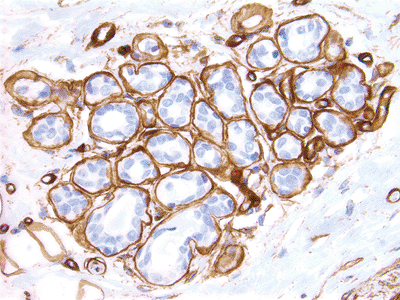 |
Figure 3.9 Immunostain for type IV collagen highlights the basal lamina around the acini of a lobule. |
The normal lobule consists of a variable number of blind-ending terminal ductules, also called acini, each with its typical double cell layer. The lobular acini are invested by a loose, fibrovascular intralobular stroma with varying numbers of lymphocytes, plasma cells, macrophages, and mast cells. This specialized intralobular stroma is sharply demarcated from the surrounding denser, more highly collagenized, paucicellular interlobular stroma and stromal adipose tissue (Figure 3.11). One feature of note that is sometimes encountered in the extralobular stroma is the presence of multinucleated giant cells (28). Their significance is unknown; and, while they may present a disturbing appearance, they should not be mistaken for the malignant cells of an invasive carcinoma (Figure 3.12).
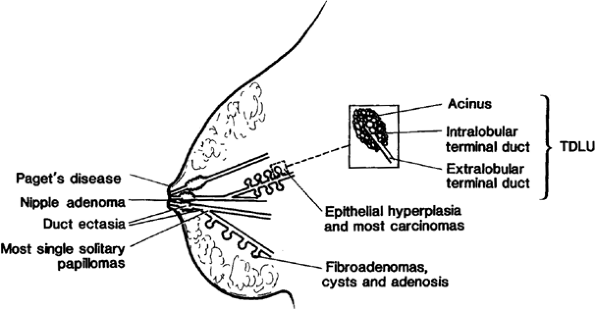 |
Figure 3.10 A schematic representation of the breast, indicating the sites of origin of pathologic lesions. (Reprinted from Schnitt SJ, Millis RR, Hanby AM, Oberman HA. The breast. Mills SE, Carter D, Greeson JK, Oberman HA, Reuter VE, Stoler MH eds. Sternberg's Diagnostic Surgical Pathology. 4th ed. Philadelphia: Lippincott Williams & Wilkins; 2004; 323 398. ) |
The size of mammary lobules and number of acini per lobule are extremely variable. Russo et al. (29,30,31) have described four lobule types. Type 1 lobules are the most rudimentary and are most prevalent in prepubertal and nulliparous women, comprising 65 to 80% of the lobules in this group (Figure 3.2). These lobules are comprised primarily of ducts with sprouting alveolar buds. Type 1 lobules gradually evolve to more mature structures (type 2 and type 3 lobules) through the development of additional alveolar buds. The number of alveolar buds per lobule increases from approximately 11 in type 1 lobules to 47 and 80 in type 2 and 3 lobules, respectively. In the parous, premenopausal woman, type 3 lobules are most prevalent, comprising 70 to 90% of the lobular elements. Type 4 lobules are those seen during pregnancy and lactation. Of interest, Russo et al. (31) have reported that type 1 lobules predominate in the breasts of women with breast cancer, regardless of pregnancy history. They have also provided experimental evidence suggesting that type 1 and 2 lobules are more susceptible to malignant transformation than are type 3 lobules upon exposure to chemical carcinogens (32). It should be noted, however, that type 1, 2, and 3 lobules commonly co-exist in the same breast and that the utility of distinguishing among them in clinical practice remains to be defined.
The lobules exhibit morphologic changes during the menstrual cycle, and these are seen in both the epithelial
P.64
and stromal components (33,34,35,36). These changes are summarized in Table 3.2. While the changes that occur during the menstrual cycle are variable among lobules in the same breast, even among immediately adjacent lobules, a dominant morphologic pattern is typically present in each phase. However, these menstrual cycle related changes are subtle when compared with the dramatic alterations seen during pregnancy and lactation and when compared with the menstrual cycle-related changes seen in the endometrium.
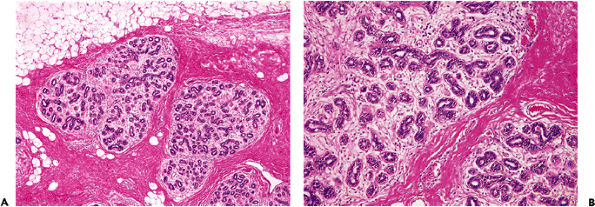 |
Figure 3.11 Intralobular and extralobular stroma. A. Low-power view of several lobules that are invested by loose, intralobular stroma. The interlobular stroma is composed primarily of dense collagen with admixed adipose tissue. B. Higher power view contrasts loose intralobular stroma with more collagenized interlobular stroma. |
Occasionally, the TDLU epithelial cells show prominent clear cell change in the cytoplasm. This may be seen in both premenopausal and postmenopausal women and appears to be unrelated to pregnancy or exogenous hormone use (37).
 |
Figure 3.12 Multinucleated stromal giant cells. A. Low-power view showing multinucleated giant cells scattered in the stroma. B. High power illustrates cytologic detail. These cells have a mesenchymal phenotype. Despite their worrisome histologic appearance, they have no known clinical significance. |
The nipple-areola complex is a circular area of skin that exhibits increased pigmentation and contains numerous sensory nerve endings. The nipple is placed centrally and is elevated above the surrounding areola. The tip of the nipple contains 15 to 20 orifices. However, as discussed earlier, the number of such openings may not correlate directly with the number of breast segments. In the nonlactating breast, these duct openings typically possess keratin plugs. The areola surface exhibits numerous small, rounded elevations, the tubercles of Montgomery.
P.65
Table 3.2 Histologic Changes in Lobules During the Menstrual Cycle (Adapted from Mccarty and Nath (8)) | ||||||||||||||||||||||||
|---|---|---|---|---|---|---|---|---|---|---|---|---|---|---|---|---|---|---|---|---|---|---|---|---|
|
Both the nipple and areola are covered by keratinizing, stratified squamous epithelium, and this extends for a short distance into the terminal portions of the lactiferous ducts. The epidermis of the nipple-areola complex may contain occasional clear cells that are cytologically benign and that must not be confused with Paget's cells (38,39) (Figure 3.13). Some of these cells represent clear keratinocytes, whereas others are thought to be derived from epidermally located mammary ductal epithelium (39).
The proximal ramifications of the mammary ductal system that are present in the dermis of the nipple typically have a pleated or serrated contour (Figure 3.14). These ducts are surrounded by a stroma rich in circular and longitudinal smooth muscle bundles, collagen, and elastic fibers (Figure 3.15). Occasionally, lobules may be seen in the nipple (40). Simple mammary ducts are also present throughout the dermis of the areola, even at its periphery, and these may extend to within less than 1 mm of the basal layer of the epidermis (41).
While the nipple-areola complex lacks pilosebaceous units and hairs except at the periphery of the areola, the dermis contains numerous sebaceous glands. Some of
P.66
these glands open directly onto the surface of the nipple and areola, whereas others drain into a lactiferous duct or share a common ostium with a lactiferous duct. The tubercles of Montgomery represent a unit consisting of a sebaceous apparatus and an associated lactiferous duct (42) (Figure 3.16). During pregnancy, these tubercles become increasingly prominent. Apocrine sweat glands may also be seen in the dermis of the nipple and areola.
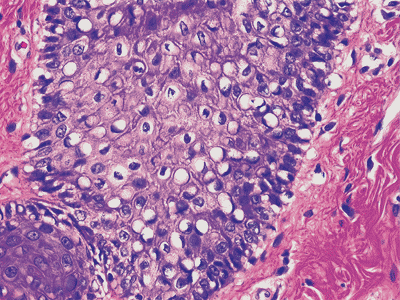 |
Figure 3.13 Clear cells in nipple epidermis. In some cells, the clearing is extreme, with formation of large intracytoplasmic vacuoles. These cells should not be mistaken for the cells of Paget's disease. |
Another finding that may occasionally be encountered within the breast parenchyma is the presence of intramammary lymph nodes (43,44). These lymph nodes may be identified as an incidental finding in breast tissue removed because of another abnormality, or they may be seen as densities on mammograms (45).
 |
Figure 3.14 Cross section through the nipple. The irregular, pleated or serrated contour of the nipple ducts is evident. |
 |
Figure 3.15 High-power view of nipple dermis/stroma, demonstrating prominent bundles of smooth muscle fibers. |
Pregnancy and Lactation
It is not until pregnancy that full development of the breast occurs in humans. During pregnancy, epithelial cell proliferation resumes. There is a dramatic increase in the number of lobules, as well as in the number of acinar units within each lobule secondary to epithelial cell proliferation and lobuloalveolar differentiation under the influence of estrogen, progesterone, prolactin, and growth hormone; growth is further enhanced by adrenal glucocorticoids and insulin. This lobular development and expansion occurs at the expense of both the intralobular and extralobular stroma. By the end of the first trimester, there is grossly evident breast enlargement, superficial venous dilatation, and increased pigmentation of the areola.
During the second and third trimesters, lobular growth continues, and the acinar units begin to appear monolayered. The myoepithelial cells in the acini are difficult to discern at this time due to the increase in size and volume of the epithelial cells, but they remain clearly evident in the extralobular ducts. The cytoplasm of the epithelial cells becomes vacuolated, and secretion accumulates in the greatly expanded lobules. After parturition, the lactating breast is characterized by distension of the lobular acini as a result of accumulated abundant secretory material and prominent epithelial cell cytoplasmic vacuolization. Many of the epithelial cells have a bulbous or hobnail appearance and protrude into the acinar lumina (Figure 3.17). Myoepithelial cells remain attenuated and inconspicuous. The florid changes seen in pregnancy and lactation can be alarming to the inexperienced observer; areas of infarction, which occasionally occur in the pregnant breast, may compound the problem (46).
When lactation ceases, the lobules involute and return to their normal resting appearance. Involution usually proceeds
P.67
unevenly and takes several months. Involuting lobules are irregular in contour and are frequently infiltrated by lymphocytes and plasma cells (47,48). Occasionally, an isolated lobule showing secretory changes may be seen in the breasts of women who are not pregnant. Although this is often called a residual lactating lobule, it may occur in the nulliparous woman as well.
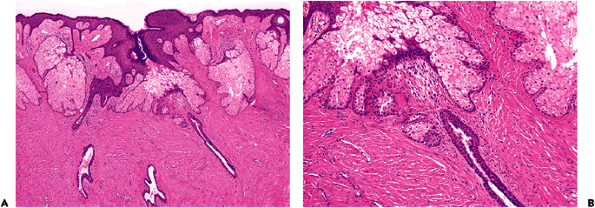 |
Figure 3.16 Montgomery's areolar tubercle. A. Low power view. B. Higher power view. These tubercles are units composed of a lactiferous duct and associated sebaceous gland. |
Menopause
During the postmenopausal period, with the reduction of estrogen and progesterone levels, there is involution and atrophy of the mammary TDLUs, with reduction in the size and complexity of the acini, and there is loss of the specialized intralobular stroma (49,50). Ducts may become variably ectatic. The postmenopausal breast is characterized by a marked reduction in glandular tissue and collagenous stroma, often with a concomitant increase in stromal adipose tissue. The end stage of menopausal involution is typified by remnants of the TDLUs, typically composed of ducts with atrophic acini, surrounded by hyalinized connective tissue or embedded within adipose tissue with little or no surrounding stroma (Figure 3.18).
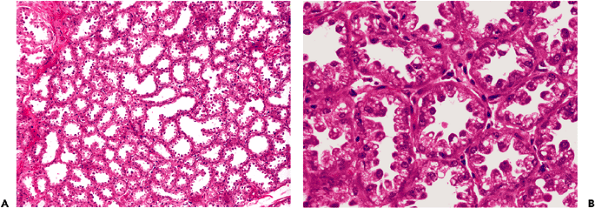 |
Figure 3.17 Lactating breast tissue. A. There are numerous acini in this lobule, and these are enlarged and dilated. There is minimal intervening stroma. B. Higher power view illustrates prominent epithelial cell enlargement, cytoplasmic vacuolization, and protrusion of cells into the acinar lumen. Some of the cells have a hobnail appearance. Myoepithelial cells are inconspicuous. |
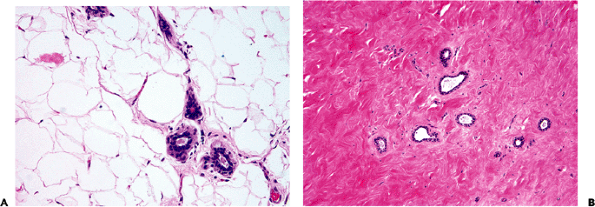 |
Figure 3.18 Postmenopausal breast tissue. A. This sample consists primarily of fatty stroma with a few atrophic ductules. B. In this specimen, a few residual, atrophic lobular acini are evident in a fibrotic stroma, which has replaced the normal, loose intralobular stroma. |
Blood Supply
The principal arterial supply to the breast is provided by the internal mammary and lateral thoracic arteries. Perforating branches of the internal mammary artery provide the blood supply to approximately 60% of the breast, mainly the
P.68
medial and central portions. Approximately 30% of the breast, mainly the upper and outer portions, receives blood from the lateral thoracic artery. Branches of the thoracoacromial, intercostal, subscapular, and thoracodorsal arteries make minor contributions to the mammary blood supply (7).
Venous drainage of the breast, as in other locations, shows considerable individual variation but largely follows the arterial system. There is a superficial venous complex that runs transversely from lateral to medial in the subcutaneous tissue. These vessels then drain into the internal thoracic vein. Deep venous drainage of the breast is via three routes: the perforating branches of the internal thoracic vein, branches of the axillary vein, and tributaries of the intercostal veins, which drain posteriorly into the vertebral veins and the vertebral plexus (5,51).
Lymphatic Drainage
Lymphatic drainage of the breast occurs through four routes: cutaneous, axillary, internal thoracic, and posterior intercostal lymphatics. The cutaneous lymphatic drainage system consists of both a superficial plexus of channels that lie within the dermis overlying the breast and a deeper network of lymphatic channels that runs with the mammary ducts in the subareolar area. Most of these cutaneous channels drain to the ipsilateral axilla. Cutaneous lymphatics from the inferior aspect of the breast may drain to the epigastric plexus and ultimately to the lymphatic channels of the liver and intra-abdominal lymph nodes.
There are three lymphatic drainage pathways in the mammary parenchyma. The most important drainage basin for lymphatic flow from the breast is the axilla, and the axillary lymph nodes receive the vast majority of the lymph drained. The internal thoracic lymphatic route carries less than 10% of the lymphatic flow from the breast and ultimately terminates in the internal mammary lymph nodes (7). Drainage eventually empties into the great veins via the thoracic duct, the lower cervical nodes, or the jugular-subclavian confluence. The third and least important route of mammary lymphatic drainage are the posterior intercostal lymphatics, which drain into the posterior intercostal lymph nodes. An understanding of the lymphatic drainage of the breast is of particular importance in the current era of sentinel lymph node biopsy since this explains the occasional finding of sentinel lymph nodes outside of the axilla (5,7,8).
The Adult Male Breast
The adult male breast, like the female breast, is composed of glandular epithelial elements embedded in a stroma that is composed of varying amounts of collagen and adipose tissue. However, in contrast to the adult female breast, the epithelial elements of the male breast normally consist of branching ducts without lobule formation.
Biologic Markers, Immunophenotype, and Molecular Biology
Estrogen Receptor and Progesterone Receptor
It is now known that there are at least two different estrogen receptors (ER), ER and ER ; ER has been far more extensively studied. Using immunohistochemistry, ER expression can be demonstrated in the nuclei of both ductal and lobular epithelial cells, with a higher proportion in
P.69
lobules than in ducts. However, even in the lobules, only a small proportion of the cells show ER immunoreactivity. Most often, ER -positive cells in the lobules are distributed singly, admixed with and surrounded by ER -negative cells (52) (Figure 3.19). Furthermore, there is considerable heterogeneity in staining for ER among lobules in the same breast. Of interest, in breast tissue from premenopausal women, there is generally an inverse relationship between expression of ER and markers of cell proliferation. In particular, most ER -positive cells do not show expression of the proliferation related antigen Ki-67, and Ki-67-positive cells are typically ER -negative. The proportion of ER -positive cells gradually increases with age but remains relatively stable after the menopause. The incidence of lobules showing contiguous patches of ER -positive cells also increases with age and with involutional changes (52). In addition, the proportion of ER -positive proliferating cells increases with age (53). In premenopausal women, ER expression varies with the phase of the menstrual cycle, being higher in the follicular than in the luteal phase (54). Myoepithelial cells do not show ER immunoreactivity.
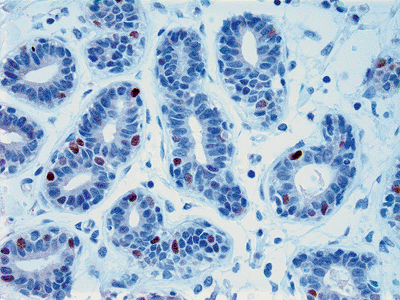 |
Figure 3.19 Immunostain for estrogen receptor- (ER ) in a normal lobule. A minority of epithelial cells show nuclear staining. |
Recent studies have indicated that a second form of ER, ER , is also expressed in normal breast tissue. Expression of ER has been observed not only in epithelial cells of ducts and lobules, but also in myoepithelial cells, endothelial cells, and stromal cells (54,55). The expression of this form of ER does not seem to vary with the phase of the menstrual cycle. It has been speculated that the relative levels of ER and ER may be important in determining the risk of breast cancer development, and that higher levels of ER relative to ER are protective against neoplastic progression in the breast (55). However, additional studies are needed to more clearly elucidate the role of ER in normal breast physiology and in breast cancer pathogenesis.
Expression of progesterone receptor (PR) has not been as extensively studied in normal breast tissue as has ER. Like ER , PR is expressed in the nuclei of ductal and lobular epithelium. However, in contrast to ER expression, PR expression does not seem to vary with the menstrual cycle phase (54).
Other Biomarkers and Immunophenotypic Features
Expression of a wide variety of biomarkers has been studied in benign breast tissue (56) and a comprehensive review of these is beyond the scope of this chapter. However, a few of these merit brief mention. Rarely, normal breast epithelium may show HER2 protein overexpression, p53 protein accumulation, or p53 mutations, but, the clinical significance of these findings is uncertain.
The anti-apoptotic protein bcl-2 is consistently expressed by normal breast epithelial cells (57). The S-100 protein is strongly expressed by normal myoepithelial cells and variably expressed by mammary epithelial cells (58). Epithelial cells also show variable expression for casein (59), -lactalbumin (60), gross cystic disease fluid protein-15 (61), and c-kit (CD117) (62), among other proteins. As noted earlier, cytokeratins 7, 8, 18, and 19 (16,17,18,19,20) are typically expressed by epithelial cells, whereas myoepithelial cells express cytokeratins 5/6, 14, and 17 (16,17,18,19,20,24).
Molecular Markers
The ability to evaluate DNA, RNA, and protein using the modern tools of molecular biology, particularly when guided by such techniques as laser capture microdissection (63), will greatly enhance our understanding of breast tumorigenesis and may even serve to redefine what constitutes normal. For example, a number of studies have shown that histologically normal TDLUs can exhibit an abnormal genotype, characterized by loss of heterozygosity (64) or allelic imbalance (65,66) at various chromosomal loci. At this time, however, the significance of these genetic alterations in histologically normal breast tissue remains to be determined. Studies of normal breast tissue using these techniques will also help define the presence and nature of progenitor cells or stem cells and their role in breast development and carcinogenesis (19,67), as well as patterns of gene and protein expression that distinguish normal from abnormal breast tissue and cells (68,69,70,71).
Conclusion
The histologic features of the normal breast are dynamic and vary with age and hormonal milieu, among other factors. An understanding of normal breast histology is essential to permit the reliable distinction between physiologic changes and pathologic alterations.
P.70
References
1. Jochelson M. Breast cancer imaging: the future. Semin Oncol 2001;28:221 228.
2. Leung JW. New modalities in breast imaging: digital mammography, positron emission tomography, and sestamibi scintimammography. Radiol Clin North Am 2002;40:467 482.
3. Koomen M, Pisano ED, Kuzmiak C, Pavic D, McLelland R. Future directions in breast imaging. J Clin Oncol 2005;23:1674 1677.
4. Hylton N. Magnetic resonance imaging of the breast: opportunities to improve breast cancer management. J Clin Oncol 2005;23:1678 1684.
5. Rosen P. Anatomy and physiologic morphology. In: Rosen's Breast Pathology. 2nd ed. Philadelphia: Lippincott Williams & Wilkins; 2001:1 21.
6. Tavassoli FA. Normal development and anomalies. In: Tavassoli FA, ed. Pathology of the Breast. 2nd ed. Stamford, CT: Appleton & Lange; 1999:1 25.
7. Osborne MP. Breast anatomy and development. In: Harris JR, Lippman ME, Morrow M, Osborne CK, eds. Diseases of the Breast. 3rd ed. Philadelphia: Lippincott Williams & Wilkins; 2004:3 13.
8. McCarty KS, Nath M. Breast. In: Sternberg SS, ed. Histology for Pathologists. Philadelphia: Lippincott-Raven; 1997:71 82.
9. Anbazhagan R, Bartek J, Monaghan P, Gusterson BA. Growth and development of the human infant breast. Am J Anat 1991;192:407 417.
10. Monaghan P, Perusinghe NP, Cowen P, Gusterson BA. Peripubertal human breast development. Anat Rec 1990;226:501 508.
11. Jensen HM. Breast pathology, emphasizing precancerous and cancer-associated lesions. In: Bulbrook RD, Taylor DJ, eds. Commentaries on Research in Breast Disease. Vol 2. New York: Alan R. Liss; 1981:41 86.
12. Page DL, Anderson TJ. Diagnostic Histopathology of the Breast. Edinburgh: Churchill Livingstone; 1987.
13. Love SM, Barsky SH. Anatomy of the nipple and breast ducts revisited. Cancer 2004;101:1947 1957.
14. Ohtake T, Kimijima I, Fukushima T, et al. Computer-assisted complete three-dimensional reconstruction of the mammary ductal/lobular systems: implications of ductal anastomoses for breast-conserving surgery. Cancer 2001;91:2263 2272.
15. Schnitt SJ, Millis RR, Hanby AM, Oberman HA. The breast. In: Mills SE, Carter D, Greenson JK, Oberman HA, Reuter VE, Stoler MH, eds. Sternberg's Diagnostic Surgical Pathology. 4th ed. Philadelphia: Lippincott Williams & Wilkins; 2004:323 398.
16. Jarasch ED, Nagle RB, Kaufmann M, Maurer C, Bocker WJ. Differential diagnosis of benign epithelial proliferations and carcinomas of the breast using antibodies to cytokeratins. Hum Pathol 1988;19:276 289.
17. Bocker W, Bier B, Freytag G, et al. An immunohistochemical study of the breast using antibodies to basal and luminal keratins, alpha-smooth muscle actin, vimentin, collagen IV and laminin. Part I: Normal breast and benign proliferative lesions. Virchows Arch A Pathol Anat Histopathol 1992;421:315 322.
18. Heatley M, Maxwell P, Whiteside C, Toner P. Cytokeratin intermediate filament expression in benign and malignant breast disease. J Clin Pathol 1995;48:26 32.
19. Bocker W, Moll R, Poremba C, et al. Common adult stem cells in the human breast give rise to glandular and myoepithelial cell lineages: a new cell biological concept. Lab Invest 2002;82:737 746.
20. Abd El-Rehim DM, Pinder SE, Paish CE, et al. Expression of luminal and basal cytokeratins in human breast carcinoma. J Pathol 2004;203:661 671.
21. Yaziji H, Gown AM, Sneige N. Detection of stromal invasion in breast cancer: the myoepithelial markers. Adv Anat Pathol 2000; 7:100 109.
22. Barbareschi M, Pecciarini L, Cangi MG, et al. p63, a p53 homologue, is a selective nuclear marker of myoepithelial cells of the human breast. Am J Surg Pathol 2001;25:1054 1060.
23. Moritani S, Kushima R, Sugihara H, Bamba M, Kobayashi TK, Hattori T. Availability of CD10 immunohistochemistry as a marker of breast myoepithelial cells on paraffin sections. Mod Pathol 2002;15:397 405.
24. Nielsen TO, Hsu FD, Jensen K, et al. Immunohistochemical and clinical characterization of the basal-like subtype of invasive breast carcinoma. Clin Cancer Res 2004;10:5367 5374.
25. Clarke CL, Sandle J, Parry SC, Reis-Filho JS, O'Hare MJ, Lakhani SR. Cytokeratin 5/6 in normal human breast: lack of evidence for a stem cell phenotype. J Pathol 2004;204:147 152.
26. Barsky SH, Siegal GP, Jannotta F, Liotta LA. Loss of basement membrane components by invasive tumors but not by their benign counterparts. Lab Invest 1983;49:140 147.
27. Wellings SR, Jensen HM, Marcum RG. An atlas of subgross pathology of the human breast with special reference to possible precancerous lesions. J Natl Cancer Inst 1975;55:231 273.
28. Rosen PP. Multinucleated mammary stromal giant cells: a benign lesion that simulates invasive carcinoma. Cancer 1979;44:1305 1308.
29. Russo J, Russo IH. Development of the human mammary gland. In: Neville MC, Daniel CW, eds. The Mammary Gland: Development, Regulation, and Function. New York: Plenum Press; 1987:67 93.
30. Russo J, Rivera R, Russo IH. Influence of age and parity on the development of the human breast. Breast Cancer Res Treat 1992; 23:211 218.
31. Russo J, Romero AL, Russo IH. Architectural pattern of the normal and cancerous breast under the influence of parity. Cancer Epidemiol Biomarkers Prev 1994;3:219 224.
32. Russo J, Mills MJ, Moussalli MJ, Russo IH. Influence of human breast development on the growth properties of primary cultures. In Vitro Cell Dev Biol 1989;25:643 649.
33. Vogel PM, Georgiade NG, Fetter BF, Vogel FS, McCarty KS Jr. The correlation of histologic changes in the human breast with the menstrual cycle. Am J Pathol 1981;104:23 34.
34. Longacre TA, Bartow SA. A correlative morphologic study of human breast and endometrium in the menstrual cycle. Am J Surg Pathol 1986;10:382 393.
35. Ramakrishnan R, Khan SA, Badve S. Morphological changes in breast tissue with menstrual cycle. Mod Pathol 2002;15:1348 1356.
36. Anderson TJ. Normal breast: myths, realities, and prospects. Mod Pathol 1998;11:115 119.
37. Tavassoli FA, Yeh IT. Lactational and clear cell changes of the breast in nonlactating, nonpregnant women. Am J Clin Pathol 1987;87:23 29.
38. Toker C. Clear cells of the nipple epidermis. Cancer 1970;25:601 610.
39. Kohler S, Rouse RV, Smoller BR. The differential diagnosis of pagetoid cells in the epidermis. Mod Pathol 1998;11:79 92.
40. Rosen PP, Tench W. Lobules in the nipple. Frequency and significance for breast cancer treatment. Pathol Annu 1985;20(pt 2):317 322.
41. Schnitt SJ, Goldwyn RM, Slavin SA. Mammary ducts in the areola: implications for patients undergoing reconstructive surgery of the breast. Plast Reconstr Surg 1993;92:1290 1293.
42. Smith DM Jr, Peters TG, Donegan WL. Montgomery's areolar tubercle. A light microscopic study. Arch Pathol Lab Med 1982;106:60 63.
43. Egan RL, McSweeney MB. Intramammary lymph nodes. Cancer 1983;51:1838 1842.
44. Jadusingh IH. Intramammary lymph nodes. J Clin Pathol 1992; 45:1023 1026.
45. Svane G, Franzen S. Radiologic appearance of nonpalpable intramammary lymph nodes. Acta Radiol 1993;34:577 580.
46. Oberman HA. Breast lesions confused with carcinoma. In: McDivitt R, Oberman HA, Ozello I, eds. The Breast. Baltimore: Williams & Wilkins; 1984:1 3.
47. Battersby S, Anderson TJ. Proliferative and secretory activity in the pregnant and lactating human breast. Virchows Arch A Pathol Anat Histopathol 1988;413:189 196.
48. Battersby S, Anderson TJ. Histological changes in breast tissue that characterize recent pregnancy. Histopathology 1989;15:415 419.
49. Hutson SW, Cowen PN, Bird CC. Morphometric studies of age related changes in normal human breast and their significance for evolution of mammary cancer. J Clin Pathol 1985;38:281 287.
P.71
50. Cowan DF, Herbert TA. Involution of the breast in women aged 50 104 years: a histopathologic study of 102 cases. Surgical Pathology 1989;2:323 333.
51. McCarty KS, Nath M. Breast. In: Sternberg SS, ed. Histopathology for Pathologists. 2nd ed. Philadelphia: Lipincott-Raven; 1997:71 82.
52. Shoker BS, Jarvis C, Sibson DR, Walker C, Sloane JP. Oestrogen receptor expression in the normal and pre-cancerous breast. J Pathol 1999;188:237 244.
53. Shoker BS, Jarvis C, Clarke RB, et al. Estrogen receptor-positive proliferating cells in the normal and precancerous breast. Am J Pathol 1999;155:1811 1815.
54. Shaw JA, Udokang K, Mosquera JM, Chauhan H, Jones JL, Walker RA. Oestrogen receptors alpha and beta differ in normal human breast and breast carcinomas. J Pathol 2002;198:450 457.
55. Shaaban AM, O'Neill PA, Davies MP, et al. Declining estrogen receptor-beta expression defines malignant progression of human breast neoplasia. Am J Surg Pathol 2003;27:1502 1512.
56. Krishnamurthy S, Sneige N. Molecular and biologic markers of premalignant lesions of human breast. Adv Anat Pathol 2002;9:185 197.
57. Siziopikou KP, Prioleau JE, Harris JR, Schnitt SJ. bcl-2 expression in the spectrum of preinvasive breast lesions. Cancer 1996;77:499 506.
58. Egan MJ, Newman J, Crocker J, Collard M. Immunohistochemical localization of S100 protein in benign and malignant conditions of the breast. Arch Pathol Lab Med 1987;111:28 31.
59. Earl HM, McIlhinney RA, Wilson P, Gusterson BA, Coombes RC. Immunohistochemical study of beta- and kappa-casein in the human breast and breast carcinomas, using monoclonal antibodies. Cancer Res 1989;49:6070 6076.
60. Bailey AJ, Sloane JP, Trickey BS, Ormerod MG. An immunocytochemical study of alpha-lactalbumin in human breast tissue. J Pathol 1982;137:13 23.
61. Mazoujian G, Pinkus GS, Davis S, Haagensen DE Jr. Immunohistochemistry of a gross cystic disease fluid protein (GCDFP-15) of the breast. A marker of apocrine epithelium and breast carcinomas with apocrine features. Am J Pathol 1983;110:105 112.
62. Chui X, Egami H, Yamashita J, et al. Immunohistochemical expression of the c-kit proto-oncogene product in human malignant and non-malignant breast tissues. Br J Cancer 1996;73:1233 1236.
63. Simone NL, Paweletz CP, Charboneau L, Petricoin EF III, Liotta LA. Laser capture microdissection: beyond functional genomics to proteomics. Mol Diagn 2000;5:301 307.
64. Deng G, Lu Y, Zlotnikov G, Thor AD, Smith HS. Loss of heterozygosity in normal tissue adjacent to breast carcinomas. Science 1996;274:2057 2059.
65. Larson PS, de las Morenas A, Cupples LA, Huang K, Rosenberg CL. Genetically abnormal clones in histologically normal breast tissue. Am J Pathol 1998;152:1591 1598.
66. Larson PS, de las Morenas A, Bennett SR, Cupples LA, Rosenberg CL. Loss of heterozygosity or allele imbalance in histologically normal breast epithelium is distinct from loss of heterozygosity or allele imbalance in co-existing carcinomas. Am J Pathol 2002;161:283 290.
67. Dontu G, Al-Hajj M, Abdallah WM, Clarke MF, Wicha MS. Stem cells in normal breast development and breast cancer. Cell Prolif 2003;36(suppl 1):59 72.
68. Sgroi DC, Teng S, Robinson G, LeVangie R, Hudson JR Jr, Elkahloun AG. In vivo gene expression profile analysis of human breast cancer progression. Cancer Res 1999;59:5656 5661.
69. Perou CM, Jeffrey SS, van de Rijn M, et al. Distinctive gene expression patterns in human mammary epithelial cells and breast cancers. Proc Natl Acad Sci U S A 1999;96:9212 9217.
70. Emmert-Buck MR, Strausberg RL, Krizman DB, et al. Molecular profiling of clinical tissue specimens: feasibility and applications. Am J Pathol 2000;156:1109 1115.
71. Espina V, Geho D, Mehta AI, Petricoin EF III, Liotta LA, Rosenblatt KP. Pathology of the future: molecular profiling for targeted therapy. Cancer Invest 2005;23:36 46.